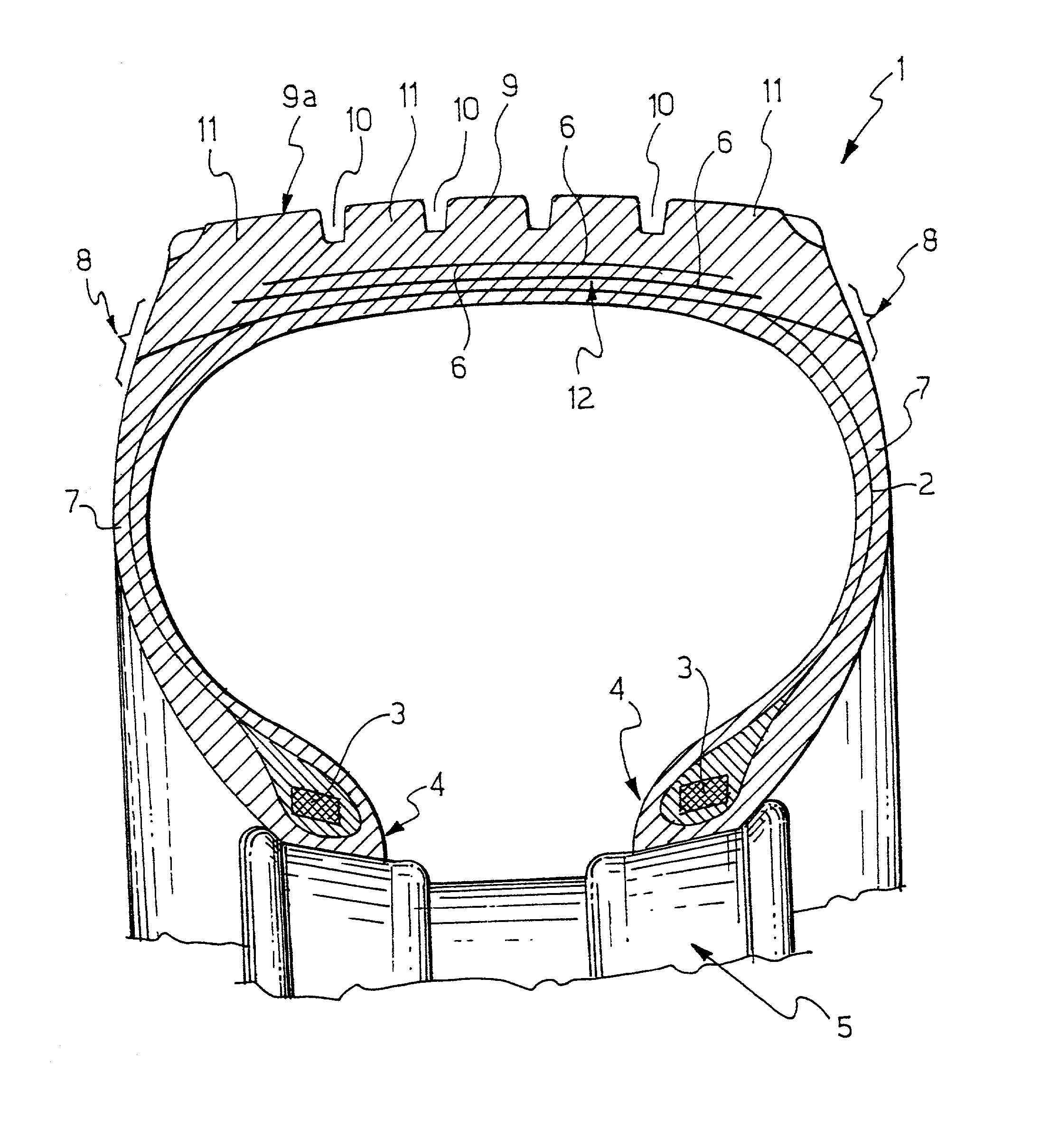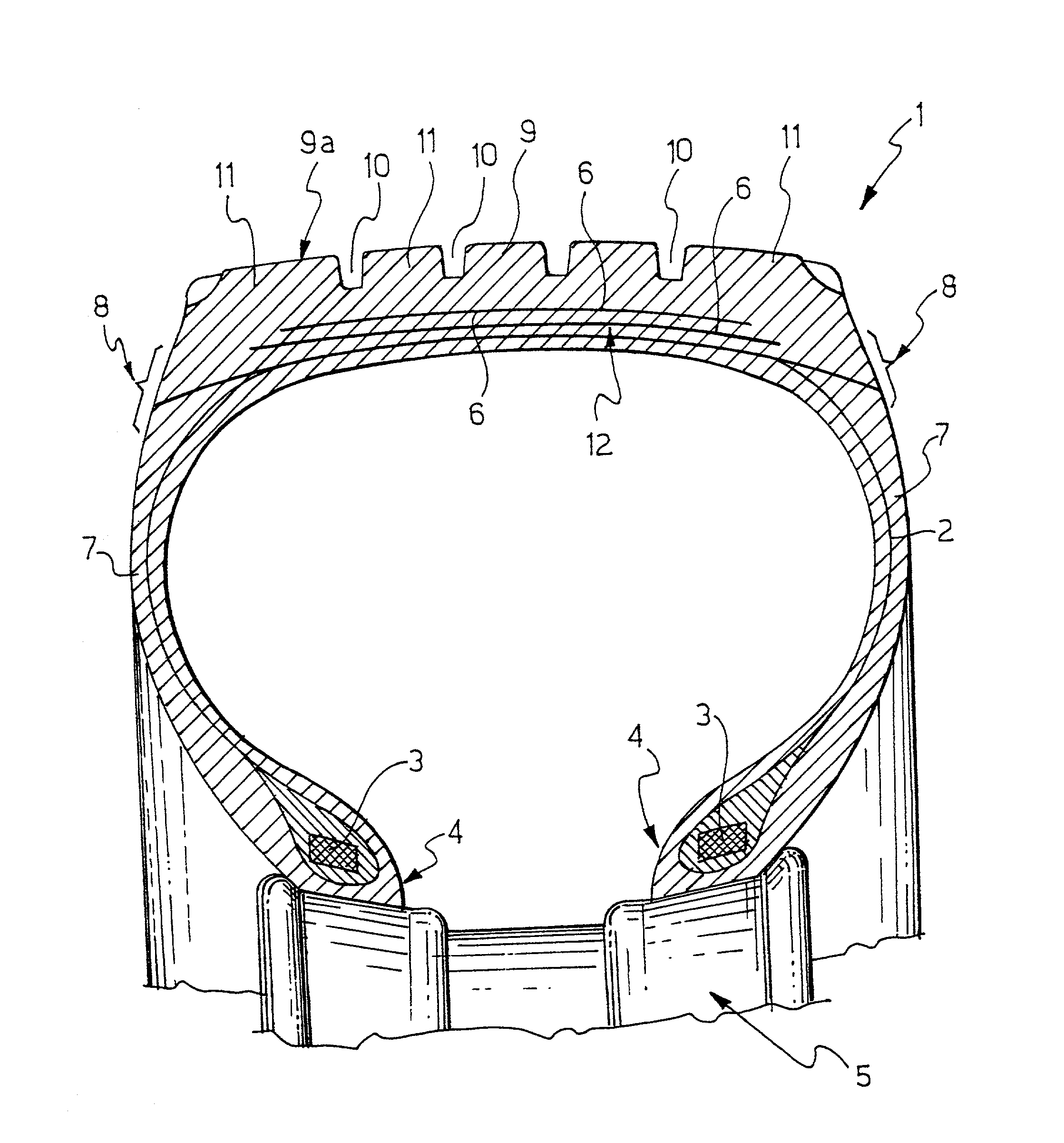Low rolling resistance tire for vehicles
a low rolling resistance, tire technology, applied in the direction of tyre tread bands/patterns, tyre parts, vehicle components, etc., can solve the problems of poor affinity requirements, affecting and so as to improve the mechanical properties of the tread. , the effect of reducing the projected area
- Summary
- Abstract
- Description
- Claims
- Application Information
AI Technical Summary
Benefits of technology
Problems solved by technology
Method used
Image
Examples
example 2
Invention
[0114] According to the procedure described in the preceding Example 1, a rubber composition was prepared including:
[0115] S-SBR-A=oil-extended butadiene / styrene copolymer, prepared in solution, having a styrene content of 20% by weight, an oil content of about 27.3% by weight and a vinyl groups content of 60% by weight, commercially available under the trade name BUNA VSL.TM. 5025-1 HM (Bayer);
[0116] BR=polybutadiene, commercially available under the trade name EUROPRENE.TM. NEOCIS (Enichem);
[0117] SiO.sub.2 B=silica in the form of substantially spherical beads commercially available under the trade name Zeosil.TM. 1115 MP (Rhne-Poulenc) having a mean aggregate size of 186 nm as measured by photon correlation spectroscopy;
[0118] carbon black N121 (Cabot);
[0119] solid silane coupling agent including 50% carbon black, 50% bis(3-triethoxysilylpropyl)tetrasulfide=X50S (Degussa);
[0120] stearic acid, aromatic type oil as plasticizer, zinc oxide, sulfur and vulcanization accelera...
example 3
Invention
[0123] According to the procedure described in the preceding Example 1, a rubber composition having the same composition of this example was prepared except for the type of silica employed.
[0124] In particular, the following silica was used:
[0125] SiO.sub.2 C=silica in the form of substantially spherical beads, commercially available under the trade name Zeosil.TM. 1135 MP (Rhne-Poulenc) having a mean aggregate size of 186 nm as measured by photon correlation spectroscopy.
[0126] The resulting composition is shown in Table I below.
[0127] Table II below shows instead the surface area characteristics of the used silica.
example 4
Comparison
[0128] According to the teaching of European patent EP 0 501 227, a rubber composition containing silica having a high surface area was prepared and in particular the following silica was used:
[0129] SiO.sub.2 A=silica commercially available under the trade name Zeosil.TM. 1165 MP (Rhne-Poulenc).
[0130] The resulting composition is shown in Table I below.
[0131] Table II below shows instead the surface area characteristics of the used silica.
PUM
| Property | Measurement | Unit |
|---|---|---|
| area | aaaaa | aaaaa |
| area | aaaaa | aaaaa |
| area | aaaaa | aaaaa |
Abstract
Description
Claims
Application Information
 Login to View More
Login to View More - R&D
- Intellectual Property
- Life Sciences
- Materials
- Tech Scout
- Unparalleled Data Quality
- Higher Quality Content
- 60% Fewer Hallucinations
Browse by: Latest US Patents, China's latest patents, Technical Efficacy Thesaurus, Application Domain, Technology Topic, Popular Technical Reports.
© 2025 PatSnap. All rights reserved.Legal|Privacy policy|Modern Slavery Act Transparency Statement|Sitemap|About US| Contact US: help@patsnap.com



